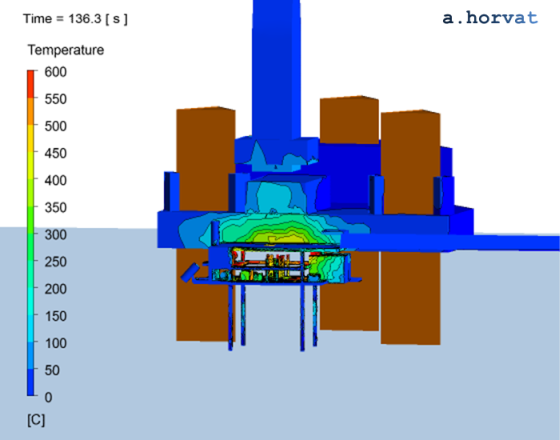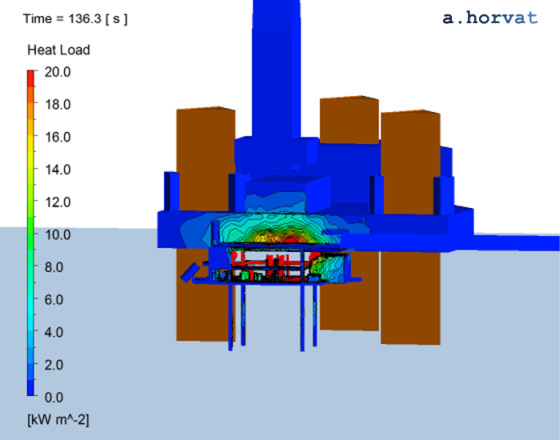Fire safety analysis for an offshore platform
Simulation analysis of a large scale gas release on an offshore platform and the subsequently ensuing
fire was conducted to determine the size of the fire ball and the resulting heat load distribution
on the surrounding structure. The initial release and its dispersion process were simulated for 2 min prior the ignition.
In this time, 1.5 tonnes of natural gas were continuously released to the environment.
Offshore platform model [ ... rotate the graphics with the mouse ]
The ignition sequence was introduced to the model to initiate rapidly developing deflagration. To simulate
the propagating fire front, Burning Velocity Model (BVM) was utilized. The local combustion reaction
was determined with the Flamelet model. In the areas where obstacles were not resolved with the
numerical grid (e.g. upper deck), a congestion model was introduced. Such model accounts for generation of turbulence
due to additional resistance and mixing, which have an effect on the flame behaviour.
An important mechanism of heat transfer is thermal radiation. The discrete transfer model with multigrey representation of radiation gases was used. Thermal emissivity of structural surfaces was set to 1.0 as a conservative estimate.
An important mechanism of heat transfer is thermal radiation. The discrete transfer model with multigrey representation of radiation gases was used. Thermal emissivity of structural surfaces was set to 1.0 as a conservative estimate.
The animation shows flammability limits and the fire related reaction region. The ignition that
started fire quickly spread across the nearest premixed region. The premixed nature of the combustion process
and the observed flame front speed are characteristic for deflagration.
Radiative heating of solid structure that raises temperature above the fuel autoignition temperature, and the horizontal gas and flame movements are two mechanisms responsible for spread of the fire onto adjacent fuel jets and associated gas clouds. The flame stabilizes underneath the weather deck with some flame spillage outside the wellbay. Eventually, the fire front spreads to the jet-air mixing layer closer to the fuel source.
Radiative heating of solid structure that raises temperature above the fuel autoignition temperature, and the horizontal gas and flame movements are two mechanisms responsible for spread of the fire onto adjacent fuel jets and associated gas clouds. The flame stabilizes underneath the weather deck with some flame spillage outside the wellbay. Eventually, the fire front spreads to the jet-air mixing layer closer to the fuel source.

Temperature of the structure due to fire
Convective heating and especially thermal radiation cause a significant thermal load on platform structures.
Peak intensities (> 300 kW/m2) occur where each of the four jet fires impinge on the underside of the weather deck.
Intensities greater than 25 kW/m2 are located throughout both decks of the affected platform. Unprotected steel in these areas is vulnerable to structural failure. Also the risk of fatalities is likely throughout the wellbay areas of the lower and mezzanine decks for extended exposure.
Intensities greater than 25 kW/m2 are located throughout both decks of the affected platform. Unprotected steel in these areas is vulnerable to structural failure. Also the risk of fatalities is likely throughout the wellbay areas of the lower and mezzanine decks for extended exposure.

Heat load to the structure due to fire
Dr Andrei Horvat
M.Sc. Mechanical Eng.
Ph.D. Nuclear Eng.
phone
+44 79 72 17 27 00
skype
a.horvat
e-mail
mail@caspus.co.uk
M.Sc. Mechanical Eng.
Ph.D. Nuclear Eng.
phone
+44 79 72 17 27 00
skype
a.horvat
mail@caspus.co.uk

